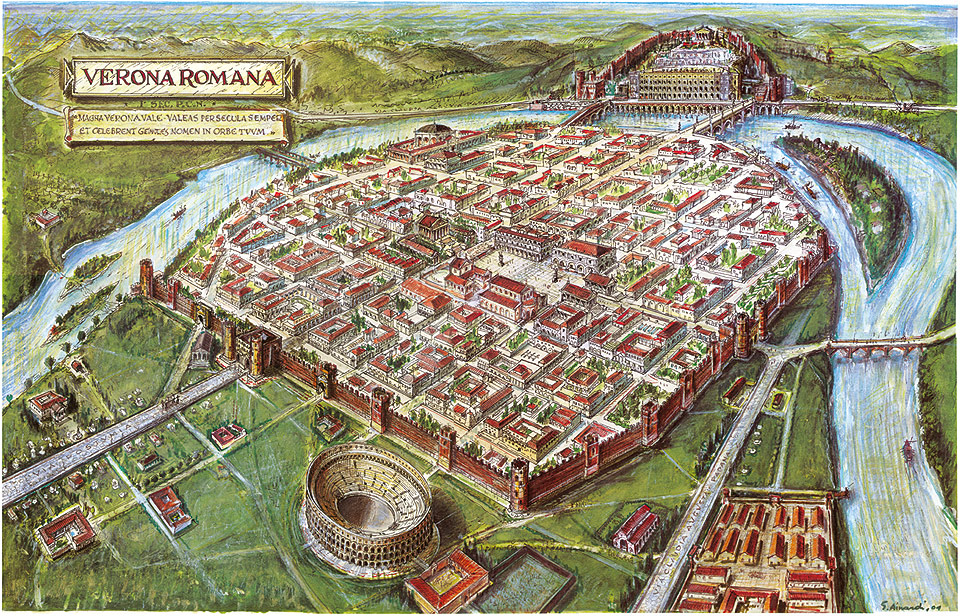
Ponte Pietra
Ponte Pietra si colloca in un luogo che, fin dalla Preistoria, rappresentò un guado naturale dell’Adige perché in questa zona il fiume raggiunge una larghezza minima di 92 metri e la corrente arriva con una potenza ridotta a causa dell’ampio meandro che deve compiere; Verona divenne quindi punto d’incontro cruciale fra tre grandi strade consolari romane:
-
La Postumia che da Genova portava ad Aquileia per proseguire per Emona, l’attuale Lubiana (SLO);
-
La Gallica che da Lugdunum, oggi Lione (F), passando per Aosta, si inseriva nella Postumia proprio a Verona;
-
La Claudia Augusta che, dipartendosi a Modena dalla Via Emilia, passava da Verona, seguiva l’Adige fino al Passo Resia e proseguiva per Augusta Vindelicum, l’odierna Augsburg (D).

La prima versione in legno di Ponte Pietra, o Pons Marmoreus, venne messa in opera nel 148 a.C. durante la realizzazione della Via Postumia (GC7G3HJ) e ad affiancarlo v’era il preesistente Pons Postumius, ovvero il Ponte Postumio che sorgeva circa 200 m. più a valle, perfettamente in asse con il Decumano Massimo, a Verona coincidente con la stessa Via Postumia, sull’attuale direttrice Corso Cavour, Corso Porta Borsari e Corso Sant’Anastasia; un’iscrizione inserita nel parapetto del muraglione in Lungadige Re Teodorico recita: “Negli scavi di fondazione vennero qui scoperti ruderi del Ponte Postumio – 1891”. (GC67W4R)

Sarebbe interessante vedere ancora oggi i due ponti quasi affiancati, ma nell’anno 905 il Ponte Postumio fu semidistrutto da una piena dell’Adige e, dopo tre secoli, nel 1239 esso cedette definitivamente all’impeto del fiume.

In oltre duemila anni di storia, numerose piene devastanti e crolli, ai quali seguirono altrettante ricostruzioni, hanno conferito a Ponte Pietra l’attuale configurazione a schiena d’asino, assai diversa da quella originaria di epoca romana; una foggia irregolare con arcate asimmetriche che serve per facilitare il flusso della corrente, in quest’ansa dell’Adige maggiore sulla riva sinistra dove si trova l’antico Teatro Romano.
Il danno maggiore e gravissimo fu però inflitto il 25 Aprile 1945, quando il ponte venne minato e fatto saltare dall’esercito tedesco in ritirata, esplosione che lasciò integra solamente l’arcata verso il centro storico della città.

Ponte Pietra venne quindi ricostruito dov’era e com’era, sulla base di un’ampia documentazione grafica e fotografica, riutilizzando il più possibile il materiale originale recuperato dal greto del fiume e seguendo i diversi metodi costruttivi adottati nelle varie epoche; sotto la direzione dell’Architetto Soprintendente ai monumenti di Verona Piero Gazzola, i lavori iniziarono il 4 Febbraio 1957 e si conclusero il 3 Marzo 1959.

La cache
ATTENZIONE
Log privi di firma sul logbook saranno cancellati senza alcun ulteriore avviso!
Non pubblicare immagini spoiler del camuffamento!
Poiché GZ è zona ad intensa presenza/passaggio di babbani, si raccomanda estrema cautela.
In particolare nel periodo natalizio ed in altre sporadiche occasioni, il ritrovamento potrebbe assumere difficoltà 5 per la presenza di bancarelle.
Buona caccia!

Ponte Pietra
Ponte Pietra is located in a place that, since prehistoric times, represented a natural ford of the Adige because in this area the river reaches a minimum width of 92 meters and the current arrives with a reduced power due to the wide meander that must fulfill; Verona thus became a crucial meeting point between three great Roman consular roads:
-
The Postumia that from Genoa led to Aquileia to continue to Emona, the current Ljubljana (SLO);
-
The Gallica that from Lugdunum today Lyon (F), passing through Aosta was inserted in the Postumia in Verona;
-
The Claudia Augusta, who moved from Modena to Via Emilia, passed from Verona, followed the Adige up to the Resia Pass and continued to Augusta Vindelicum, today’s Augsburg (D).
The first wooden version of Ponte Pietra, or Pons Marmoreus, was put in place in 148 BC, during the construction of the Via Postumia (GC7G3HJ) and alongside it there was the pre-existing Pons Postumius, or the Postumian Bridge that stood about 200 meters further downstream, perfectly aligned with the Decumano Massimo, in Verona coinciding with the same Via Postumia, on the current Corso Cavour, Corso Porta Borsari e Corso Sant’Anastasia; an inscription inserted in the parapet of the wall in Lungadige Re Teodorico states: “In the escavation of foundation, ruins of Postumian Bridge were discovered here – 1891”. (GC67W4R)
It would be interesting to see still today the two bridges almost side by side, but in the year 905 the Postumian Bridge was semi-destroyed by a flood of the Adige and, after three centuries, in 1239 it definitively gave way to the river’s impetus.
In over two thousand years of history numerous devastating and collapsing floods, to which so many reconstructions followed, have conferred on Ponte Pietra the current humpback configuration, very different from the original one of the Roman era; an irregular shape with asymmetrical arches that serves to facilitate the flow of the current, in this bend of the Adige major on the left bank, where the ancient Roman Theater is located.
The greatest and most serious damage was however inflicted on April 25, 1945, when the bridge was mined and blown up by the retreating German army, an explosion that left only the archway intact towards the historic centre of the city.
Ponte Pietra was then rebuilt where it was and how it was, on the basis of extensive graphic and photographic documentation, reusing as much as possible the original material recovered from the riverbed and following the different construction method adopted in differente eras; under the direction of the Architect Superintendent of the monuments of Verona Piero Gazzola, the works began on February 4, 1957 and ended March 3, 1959.
The cache
WARNINGS
Logs without signature on the logbook will be deleted without any further notice!
Don't post spoiler pictures of the camouflage!
Since GZ is an area with an intense presence/passage of Muggles, extreme caution is recommended.
In particular during the Christmas period and in other sporadic occasions, the find could reach difficult 5 rating due to the presence of stalls.
Happy hunting!
